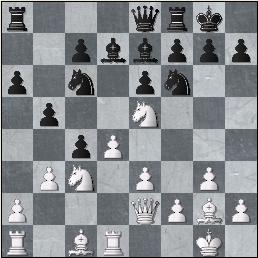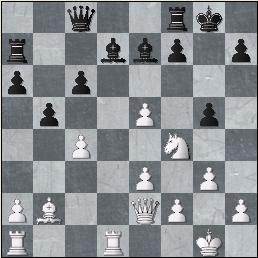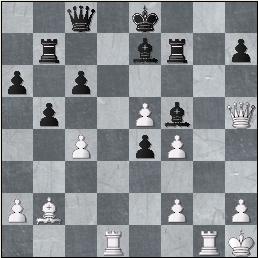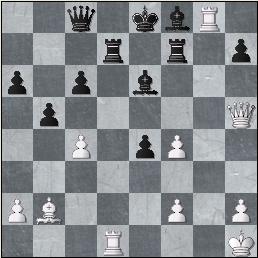20.02.2007
Game of the Round (2)
Aronian,L (2744) - Carlsem,M (2690) [E04]
XXIV SuperGM Morelia/Linares MEX/ESP (2), 18.02.2007
1.d4 ¤f6 2.c4 e6 3.g3 d5 4.¤f3 dxc4 5.Ґg2 a6 6.0-0 ¤c6 7.e3 Ґd7 8.Јe2 b5 9.¦d1 Ґe7 10.¤c3 0-0 The idea just to castle in this position has never crossed anyone's mind before. Previously occurred 10...¤d5 11.a4 0-0 and in Beliavsky-Akopian, EU-chTPula 1997 White faced some problems; after 10...¦b8 11.¤e5 ¤xe5 12.dxe5 ¤d5 13.¤xd5 exd5 14.Ґxd5 Јc8 Black has returned the extra pawn and managed to hold his position, Ryskin-Panchenko, Katowiceop 1992
11.¤e5 Јe8 12.b3! A strong move, it is difficult for Black to unpin his pieces.

12...¤d5 If at first to exchange12...cxb3 13.axb3 and now to choose13...¤d5, then after 14.¤xd5 exd5 15.Ґxd5 ¤xe5 16.dxe5 (to take an exchange is evidently unsuitable:16.Ґxa8 Ґg4 17.f3 Јxa8 18.fxg4 ¤f3+) 16...c6 17.Ґg2+/= the structure is advantageous to White. So Carlsen tries to get quite an acceptable position after possible at the moment 13.¤xd5 exd5 14.Ґxd5 ¤xe5 15.dxe5 (15.Ґxa8 Ґg4 16.f3 Јxa8 17.fxg4 ¤f3+) 15...c6 16.Ґg2 Ґe6 But now White acquire an additional opportunity – to win a pawn though at the cost of light-squared bishop exchange...
13.Ґxd5! Aronian has no problems with evaluation of unconventional positions. In this case pawn is more important.
13...exd5 14.¤xd5 ¤xe5 15.dxe5 ¦a7 16.bxc4 c6 17.¤f4 Јc8 18.Ґb2?! White has acquired an advantage due to an extra pawn, but this natural move serves to lose most of it. A precise move is 18.e4! Black does not miss his chance to get counterplay:
18...g5! The necessity to drive the knight from the good square is in this case much more important than the weakening of the king.

19.e4?! A desire not to yield the initiative to the young opponent seems logical, but the offer is unreasonably risky. Let's try and search for some clarity.
1) 19.¤g2 Ґe6 20.cxb5 (Pawn sacrifices do not lead to anything special, after 20.c5?! Ґxc5 21.Ґd4 Ґxd4 22.exd4 f6! White does not have time to consolidate, and Black has excellent play; after 20.e4!? Ґxc4 21.Јh5 Јe6 22.¤e3 White has enough compensation for the sacrificed flank, but no more than that.) 20...axb5 21.e4 (Let's try to take over the initiative for all that) 21...¦xa2 (21...¦a4 makes some sense) 22.¦xa2 Ґxa2 23.¤e3 Ґe6 (23...Јe6 24.¤f5) 24.Јc2 Јb7 (the exchange 24...¦d8 serves only to make Black's task harder: 25.¦xd8+ Ґxd8 26.Јc5) 25.¤f5 c5 26.¤d6 Јb6 and all that looks very much like dynamic equality. A rough variation: 27.f4 f6 28.f5 Ґb3! 29.Јxb3+ c4+ 30.Ґd4 Јxd4+ 31.¦xd4 cxb3 32.¦d3 b2 33.¦b3 b4 does not change the evaluation;
2) After seemingly clumsy 19.¤d3 it, in all probability, seems worth while for Black to decline to take the pawn, after 19...bxc4 20.¤e1 ¦b7 21.Ґc3 Ґe6 22.¤f3 White manages to "settle" his pieces, and black weaknesses become telling. Probably stronger is19...с520.¦ac1 Ґe6 21.cxb5 axb5 22.a3 ¦d8 with an unclear position;
3) Tactical way 19.Јd3 leads to equality: 19...Ґg4! (bad is19...gxf4? 20.e6 fxe6 (20...Ґxe6 21.Јd4 f6 22.Јxa7) 21.Јd4 Ґf6 22.Јxa7 Ґxb2 23.¦ab1+-) 20.e6 f6 21.¤g6 hxg6! (after 21...Ґxd1 22.¤xf8 Ґxf8 23.¦xd1 Јxe6 24.Јd8 ¦f7 25.¦d4 or 25.¦c1 White still retains small pressure) 22.Јxg6+ ўh8 23.Јxg5!? Ґxd1 24.¦xd1 Јxe6 25.Јh6+ ўg8 26.Јg6+ ўh8 and White has to give a perpetual check, as 27.¦d4? loses because of Јh3!;
4)19.e6 Ґxe6 20.Јd3 is obviously of no use even after simple 20...f6;
5) Kasparov indicates an opportunity 19.¦xd7 Јxd7 20.e6 fxe6 21.¦d1 Јc8 22.¤d3 (22.Јg4? e5!-+) "with compensation". I think it is quite clear to everybody what does the computer thinks about it. Funny that it was Kasparov who has become a powerful engine of the "analytical tradition" in chess. As a result of natural development of this tradition a computer with an extra exchange arouses much more confidence than Kasparov down an exchange... After 22...¦d7 23.Јg4 ¦dd8 with an idea 24.h4 e5 White has to struggle for equality. So we have penetrated deeper, found some hidden resources of the position...And now attention everyone! Let a second category player, desirably dullish, play as White. He, having spent a minute of his time, would have made the only three moves from his point of view: 19.¤g2 Ґe6 20.cxb5 axb5 21.a3 I think he would be right. Black position looks esthetic, but his king is weak, and White is a pawn up and has somewhat better chances. He also plans e3-e4 and ¤g2-e3. Let us also note that if our hypothetical second category player mechanically learns by rote the theory of some fashionable variations he will become an IM hands down. Thisismodernchess, sadasitis.
19...gxf4 20.gxf4 f5! This move devaluing the whole White's attackhas been either missed or underestimated by Aronian. Having seen 20...f5 you wouldn't want to consider the alternatives 20...Ґg4 and 20...Ґe6.
21.Јe3 Aronian finds the only way to keep the fading initiative alive. 21.ўh1 Ґe6 (21...Ґe8 with an idea ofҐg6, Јe6, possibly, is still more convincing) 22.¦g1+ ўh8 23.Јe3 ¦d7 24.Јh3 Ґc5 and white threats are inadequate.
21...¦b7 21...c5 is equally good.
22.Јg3+ The king has to be tempted to the center, 22.ўh1 Ґe6 23.¦g1+ ўh8 24.Јh3 bxc4 25.Јh6 ¦g8!?-+ promises no hopes.
22...ўf7 23.Јh3 ўe8 24.Јh5+ the h7-pawn, of course, is of no value: 24.Јxh7 Ґe6 /\25.Јg6+ Ґf7!
24...¦f7 25.ўh1 fxe4 is quite a safe way, and 25...Ґf8!?
26.¦g1 Ґf5 27.¦ad1

27...¦d7?? Black stumbles at the moment when he has practically beat back the attack of his opponent. The most precise decision is 27...Ґg6! demands foreseeing after 28.¦xg6 hxg6 29.Јxg6 the only move 29...Јh3™ In an ending without a rook: 30.Јxe4 (30.Јxc6+ ¦d7) 30...¦h7 31.Јxc6+ ўf8 32.Јg2 bxc4 it is high time for White to resign. Any one of the moves 27...Ґf8; 27...bxc4; 27...c5 leaves the position absolutely won, the white threats has run dry.
28.e6! Ґxe6 29.¦g8+ Ґf8

30.¦xf8+ Quite a fine-looking move is 30.¦dg1!? (with ideas of Ґg7, Ґa3) 30...ўd8 (all the rest is much worse:
a) 30...¦d8?! 31.Ґf6! and White already has an obvious advantage;
b) 30...¦d3 (xa3) 31.Ґg7 ўd7 32.Ґxf8 and the position is unclear;
c) 30...¦de7 31.f5! (to take the queen is not healthy: 31.¦xf8+? ўxf8 32.Јh6+ ўe8 33.¦g8+ ўd7 34.¦xc8 ўxc8-+) 31...Ґxf5 32.¦xf8+ ўxf8 33.Јh6+ ¦g7 34.Ґxg7+ and White does not take chances) 31.Ґg7 The strongest move.( a)31.Јh6 Ґxc4 32.¦xf8+ ¦xf8 33.Јxf8+ ўc7 with an obvious advantage. b) of no help is 31.Ґa3 ¦de7 32.¦1g7!? (after32.Ґxe7+ ўxe7 white threats are inadequate) 32...ўd7 33.¦xf7 (an interesting order of captures: 33.Ґxe7 ¦xg7 34.Ґxf8! Ґxg8! 35.Ґxg7 Ґxc4 36.Јxh7 Јg8-+ and White is unable to save an ending with different-colored bishops in spite of the material equality.) 33...Ґxf7 34.Јf5+ Ґe6 35.Јxf8 Јxf8 36.¦xf8 ¦f7-+, and the ending of the previously mentioned kind is lost as well) and both after 31...ўc7 32.Јe5+ ўb7 33.Јxe6 ¦xg7 34.¦1xg7 ¦xg7 35.Јxc8+ ўxc8 36.¦xf8+ and after 31...¦f5 32.Ґxf8 ўc7 33.Ґd6+ ўb7 (33...ўxd6!?) 34.Јxf5 Ґxf5 35.¦xc8 ўxc8 36.c5 White, considering the material equality, can count on a draw.
30...ўxf8 31.Јh6+ ўe7 Having made a blunder and being troubled for time, Magnus makes a reasonable practical decision. Objectively Black could have fully fight for victory after 31...ўe8, but after 32.Јxe6+ ўd8 33.Ґd4 (or 33.¦g1 ўc7 34.cxb5 axb5 35.a4) 33...ўc7 34.cxb5 axb5 35.a4 (35.Јxe4 ¦d5) 35...¦de7 36.Јb3 Јe6 37.Јg3=/+ I can see no way of comfortably cashing in on an extra exchange.
32.Јg5+ ўf8 33.Јh6+ 1/2-1/2
